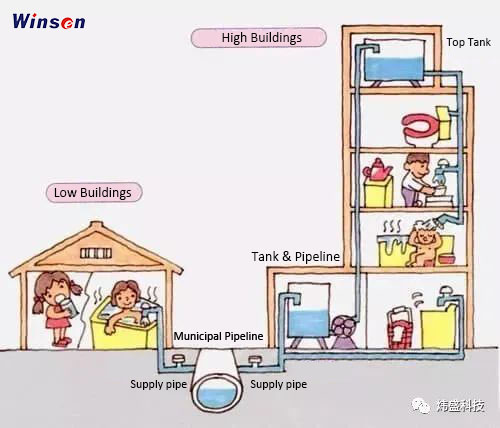
Pressure Sensors Use in Urban Secondary Pressed Water Supply System
2022-11-08When the demand for water pressure and water volume of drinking water in civil and industrial buildings exceeds the capacity of urban public water supply or the network of self-built facilities, secondary water supply will be realized through operations on pipes facilities such as storage, pressurization, etc.

Figure 1. High building water supply
Before the municipal pipe network water supply reaches the user terminal, it must go through the processes of water storage, pressurization, and water purification in the user's communities. Among them, the no vacuum water supply system and the variable frequency constant pressure water supply system are two common major facilities in the secondary water supply.
No vacuum water supply system
At present, in order to prevent the impact on the water use of urban residents, it is not allowed to install civil and production water pumps directly on the municipal pipeline network in China. In order to solve the problem that the water supply equipment can be connected on the municipal network without generating vacuum, and without affecting water supply of other users, it is necessary to add flow controllers, split-cavity pressure stabilization compensation tanks, etc. between the pump inlet and the municipal pipe network. The flow controller constantly monitors the pressure of the municipal pipe network. While ensuring that the municipal pipe network does not generate vacuum, it can also make full use of the original pressure of the municipal pipe network. Then it is necessary to use a no vacuum water supply system.
When tap water from the municipal pipeline enters the regulating tank at a certain pressure, the air in the tank is discharged through the vacuum eliminator. After the water is full, the vacuum eliminator automatically closes. When the tap water supply can meet the demand of water pressure and volume, the water supply equipment directly supplies water to the water pipe network through the bypass check valve; When supply pressure can not meet water demand, the system will send start signal to water pump for running with working of pressure sensor or pressure control device.
Inverter Constant Pressure Water Supply System
This system is mainly composed of PLC control unit, inverter, pump motor, water supply pipeline, storage tank and pressure sensors, etc. See below figure 2:

During working, pressure switch or pressure sensors installed on supply pipeline, can detect and measure pressure changes with water volume changing, and constantly send changing signals to microcomputer. According to different running conditions, the system is able to control dynamically compensation volume and consequently achieve pressure balance, and ensure pipeline pressure to be constant and meet users water demand.
Winsen pressure sensor/pressure transmitter
Pressure sensor plays important roles in both types of water supply systems. To use pressure sensors can solve unstable water supply problem, and also can lower afterward maintenance cost. Operators will be able to make analysis after receiving data from pressure sensors to find root cause, solve problems accordingly in best short time and therefore ensure residential water use.
.jpg)
.jpg)
.jpg)